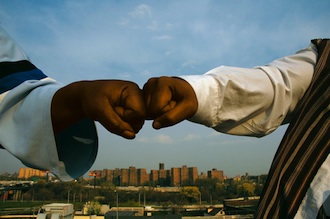By: Summer Yasmin
It takes more than a random assortment of words, put to some beats and projected by a cars-money-women persona, to be called an artist. It’s ironic that for an industry that preaches “keeping it real” much of mainstream music runs off of fantasy. But what if one wants to break the mold and use this very powerful medium to tell the truth, challenge misconceptions, share histories and cultures? It has already been done; since the beginning of time; once an oral tradition, music was the live story of people.
Many artists have begun to tap back into this forgotten creative supply. Some have actually started here. If they’re not a big name, we often don’t see or hear the results of this on the mainstream scene. But those that do it have something very unique to offer: ancient sounds with new beats, multilingual lyrics and deep messages. They may not be climbing the charts but they are walking the streets and that’s where the inspiration starts.
There are many out there and we found some in the most unexpected of places. They are rapping about their history and culture, dropping beats that their ancestors once played on hand made instruments. They speak of the world, its people, its problems and its hopes. Some of them use their talents to not only educate, but to stay alive.
In South East Asia, boarding China and Russia lies Mongolia; a barely talked about nation, at least as far as hip hop goes. It is here that a new breed of artistry, “Nomadic Hip Hop”, is coming to life. “In 1991 Mongolia broke from socialism. And a search for identity began. At that time Mongolia was just like a sheet of white paper; anything you did was new. That’s when the roots of Hip Hop started”, Says Quiza, of “Mongolian Bling”. Mongolian Bling introduces a thriving music scene in the capital, Ulaanbaatar. Artists speak of the daily struggles under a bureaucratic system, of youth hungry for modernization and elders desperate to hold on to ancient traditions. You meet Mongolia’s first female rapper and hear the sadness in anothers voice as he admits that the alcohol industry is one of the only few that will support their musical ambitions. Mongolian Bling also represents the “elders” of its society, who claim that hip hop originated from Mongolia and traveled to America from there. They site Mongolian folk songs that bare an uncanny resemblance to modern day rap. “Imagine, the background beat mentioning social issues, then the morin khuur goes, the throat singing goes, and in the front, the hip hop goes. That’s cool”, says one mother of an aspiring Mongolian singer. To mix the traditions of their elders with the sounds of modern music seems to be Mongolian Bling’s identifying factor: “While many artists will aspire to the West a handful are using hip hop to try and salvage their country’s flailing democracy and bringing Mongolia’s rich musical history into their modern beats and rhymes”
Another unlikely place to find heated lyrics and heavy beats is Afghanistan, especially when coming out of the mouth of a woman. Soosan Firooz is Afghanistan’s first female rapper. But you won’t see this young lady in stilettos and jewels. In the studio she wears a veil loosely draped over her classic bandana and hoops. Her voice has remarkable fluctuation; one minute soft and angelic, the next harsh and demanding. Her debut single Ghoomshoodin; lost, tells the story of Afghan refugees and the country’s turbulent history. The number is a fitting mix of traditional Afghan sound and modern rap lyrics in perfect representation of the artist herself. “Like wingless birds, with no wings. We were lost, lost around the world”, Firooz describes the refugee experience. “In a strange country our child was abused. Our educated ones became street workers. We ate our own body when we were starved; we drank our own tears when we were thirsty.” She says into the mic; a finger stabs in the air as each point on her list is made. She gives voice to taboos like child abuse, drug addictions and cast, nationality and gender based discrimination. She also describes the fear of losing one’s heritage and cultural identity “I don’t know. I don’t know. Oh my God. We have forgotten our own tongue”. But despite this, Firooz ends on a positive note, leaving a message of hope, pride and resilience in the face of those who would have her life for doing what she does.
If hip hop can be found in Mongolia and Rap in Afghanistan then why not Orchestra in Nairobi? They call themselves the “Ghetto Classics”. From a dingy room, in Kenya’s Korigocho slum one can hear them tirelessly working to master classics like Brahms and Beethoven. All their instruments are borrowed or donated and they struggle with the endless grind of poverty, crime and disease. This group of young people has turned away from a life on the streets to life in music by forming an amateur orchestra that uses its budding talents to survive and enlighten themselves, their peers, families and communities. They are not world class musicians yet they inspire thousands to change who they are inside and perhaps see a future outside of the slums. Ghetto classics may not have mastered Beethoven yet but they have mastered the art of making something beautiful in an ugly place.
Many see tradition, culture and heritage as impediments to modernization and popularity. However these young artists prove this notion wrong. They have found a way to use their past to shed new light on the present and reshape the future.






























Comments